If you are seeking a reason to visit Vietnam, Vietnamese food should be a pop-up in your mind to discover this country’s irresistible charm. Here are the top 8 Vietnamese dishes to delight in, featuring amazing street food, iconic dishes, and remarkable flavors, which are found across the country.
Vietnamese traditional food such as Banh Mi or Pho is represented on the world culinary map, with its original name, which showcases the popularity of the cuisine. There are many specialties about it:
With the diverse climate influenced by the tropical monsoons, and a range of altitudes, and latitudes, the country’s agriculture is enriched for cultivation in seasons of the year, harvesting multiple types of vegetables, rice, grains, and other gifts from nature, then becoming the freshest ingredients of dishes; Not only the weather but also the dynamic cultures of each region, from the North to the South, set a sense of varied ways in cooking food; Last but not least, after thousand years in the colonial history, impacted by the cuisine of other countries, Vietnamese food has been diversified with many versions, creating a fascination for unwrapping the diversity.
While planning the next trip, you may find this guide helpful not to miss any of the best 8 Vietnamese dishes ever. All of the following suggestions will attract any foodie for their unique combinations of flavors, typically tropical ingredients, and most importantly, they are signature.
Pho
Pho is a notable dish of Vietnam, just like Pizza of Italy, Sushi of Japan, or other signature options of all countries in the world. Originating in the time between the late 19th and early 20th century, this dish has been modified into many versions through regions based on the locals’ preferences. However, it is believed that Pho in Hanoi and Nam Dinh is most authentic in the North, while Pho served in Ho Chi Minh City may attract foreign visitors for a pleasant taste.
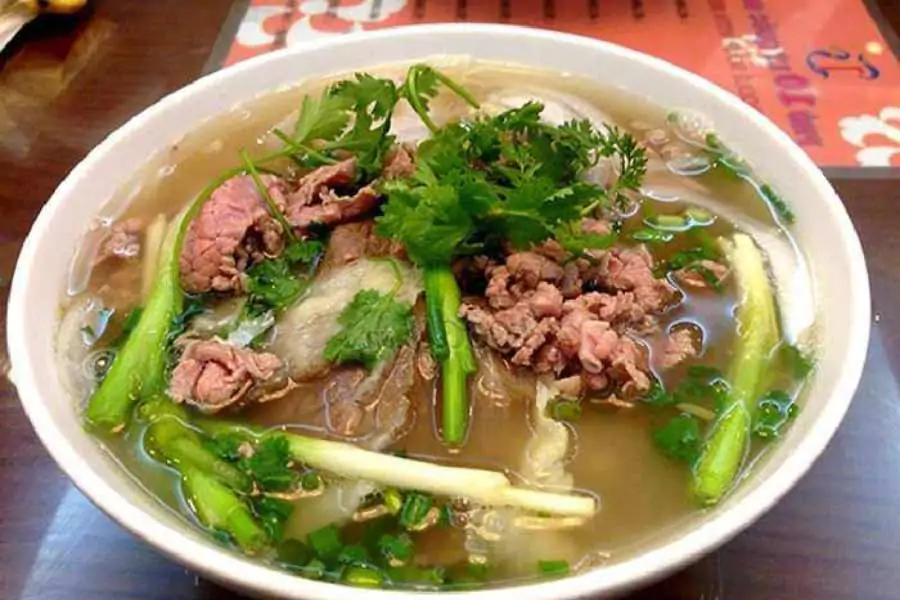
No matter what version, its attraction comes from a balanced combination of warm broth, boiled hours to get the essence from beef or chicken bones, meat, soft rice noodles (Banh Pho), and spring onions. The taste is savory, and slight with a scent of herbs like cinnamons, and star anise. The broth is considered perfect if it is clear and not greasy, without impurities. “Banh Pho” is flat and it has an amazing structure. While beef Pho (Pho Bo) delivers such an aromatic and appetizing taste, chicken Pho (Pho Ga) leaves an elegant aftertaste.

In Ho Chi Minh City and others in the South, the cooks also add beef balls, then suggest guests savor it with chili and hoisin sauces for a sweeter taste. Whereas, in Hanoi, it is not rare to catch a sense of a Pho stall on the sidewalk street where the cooks assemble each bowl with ingredients to serve while it is still hot, shrouded in clouds of steam that are pleasing on a cold Winter day. Here are some places for Pho:
Hanoi:
- Pho Thin, 13 Lo Duc, Hanoi (since 1979)
- Pho 10 Ly Quoc Su, 10 Ly Quoc Su, Hanoi
- Pho Vui, 25 Hang Giay, Hanoi
- Pho Lam, 48 Hang Vai, Hanoi
- Pho Khoi Hoi, 50 Hang Vai, Hanoi
- Pho Ga (chicken Pho) Nguyen, 5B Phu Doan, Hanoi
- Pho Ga Cham, 64-68 Yen Ninh, Hanoi
Nam Dinh:
- Pho Dan, 128 Hai Ba Trung, Nam Dinh
- Pho Tao, 44 Tran Phu – Tran Dang Ninh
Ho Chi Minh City:
- Pho 2000 Saigon, 208 – 210 Le Thanh Ton Street, District 1
- Pho Hung, 243 Nguyen Trai, District 1
- Pho Le, 415 Nguyen Trai, Ward 7, District 1
- Pho Phu Gia, 146e Ly Chinh Thang, Ward 14, District 3
- Pho Anh, 8 Ky Dong, Ward 9, District 3
Price from: US$2 – US$4/ bowl
Banh Mi
Banh Mi always has two parts: the wrap, or bread, and the fillings featuring options of meats, vegetables, and condiments. It is interesting that its “mother” is the French Baguette, brought to Vietnam with the French during the colonial period in the early 19th century. Through time, the locals have twisted it by using less flour for the bread and making it crispier as their preference.

If Pho has some versions, Banh Mi even has more across the country, with a vast array of options of fillings from fried eggs, Vietnamese sausages, cold meats, Vietnamese pate, crispy pork, grilled chicken, and meatballs to marinated fish. Whatever the fillings are, it has a balanced taste made up of a combination of salty protein ingredients, sweet and sour pickled vegetables including carrot, daikon, or cucumber, and adding cilantro, and seasonings like soy sauce, tomato sauce, chili, pepper, etc. All the ingredients are basic, but they are blended so well with layers of flavors and structure.

While being in Hanoi, you may choose to have a traditional Banh Mi filled with Vietnamese sausages, pate, pork floss, fried eggs, or a modern version of lemongrass grilled beef, and chicken; Hai Phong is super famous for unique Banh Mi Chao, or Banh Mi served by side with beef or pork, eggs, and sausage on a small pan, complimentary with pickled vegetables.
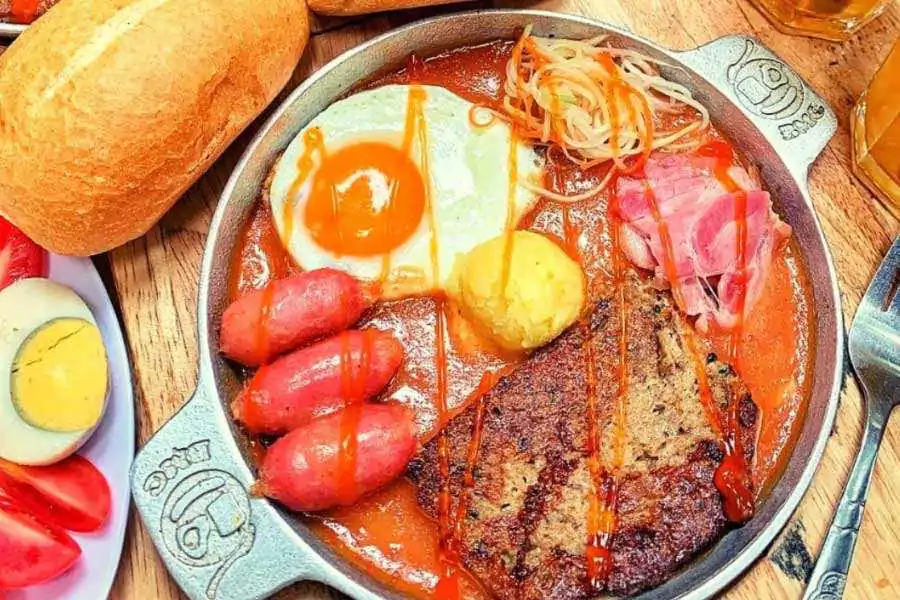
Some spots:
- Banh Mi Ba Dan, 34 Lo Su, Hanoi
- Veggie Banh Mi Tran Hung Dao, 66B Tran Hung Dao, Hanoi
- Banh Mi Pho Hue, 118A Pho Hue, Hanoi
- Banh Mi Lan Ong, 20 Cha Ca, Hanoi
- Banh My Ky Dong, 15 Ky Dong, Hai Phong
- Banh Mi Hani, 15B/87 To Hieu, Hai Phong
In the Middle to the North, Da Nang and Hoi An’s Banh Mi attracts so many visitors for its crispy or grilled pork and super spicy chili sauce; Da Lat has Banh Mi Xiu Mai, which means Banh Mi with meatballs, that you should not miss to enjoy a savory taste; Ho Chi Minh City is the last spot in this Banh Mi guide, but absolutely the place with marvelous options from the traditional one, the modern modifications to exotic choices like slow cooked pulled pork Banh Mi, mixed Vietnamese Ham Banh Mi, veggie Banh Mi with tofu, fish cake Banh Mi, and more.
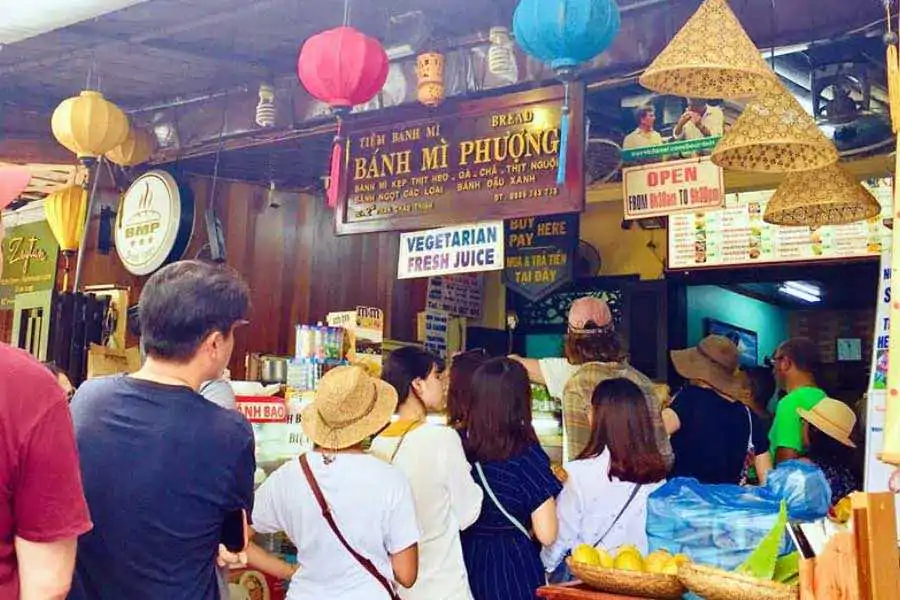
Some spots:
- Banh Mi Phuong, 2B Phan Chau Trinh, Hoi An
- Banh Mi Madam Khanh, 115 Tran Cao Van, Hoi An
- Banh Mi Xiu Mai 79, 119C Nguyen Van Troi, Ward 2, Da Lat
- Banh Mi Huynh Hoa (mixed Banh Mi), 26 Le Thi Rieng, District 1, HCMC
- Slowed Cooked Pulled Pork, Tam Cau, 460 Dien Bien Phu Street, District 10, HCMC
- Crispy Pork Belly Banh Mi, A Tai, 75B Duong Ba Trac, Ward 8, District 8, HCMC
Price from US$1/ unit
Goi Cuon (Fresh Spring Roll)
Vietnamese food leaves a strong impression of freshness, and Goi Cuon is a tantalizing dish. It contains various ingredients like shrimp, pork, chives, a mix of vegetables, and vermicelli wrapped in rice paper. That is why it is a healthy dish. When having Goi Cuon, you may dip it into Nuoc Cham (fish sauce mixed with sugar, and vinegar in a portion and adding chili as well as garlic), or hoisin-peanut sauce. It is simply delicate, with a natural taste of each element, boosted by a garlicky note and a balance of sweet, sour, salty flavor of Nuoc Cham.

Of course, the availability of versions means that each region has its own Goi Cuon. Just discover: Pho Cuon (stirred beef wrapped in the flat-shaped Banh Pho) in Hanoi, grilled pork sausage with lemongrass dipped in Mam Nem in Nha Trang, crispy pork Goi Cuon in Da Nang, Hue’s Goi Cuon, Bo Bia with sausage, and dried shrimp in Ho Chi Minh City or other Northern provinces, etc.

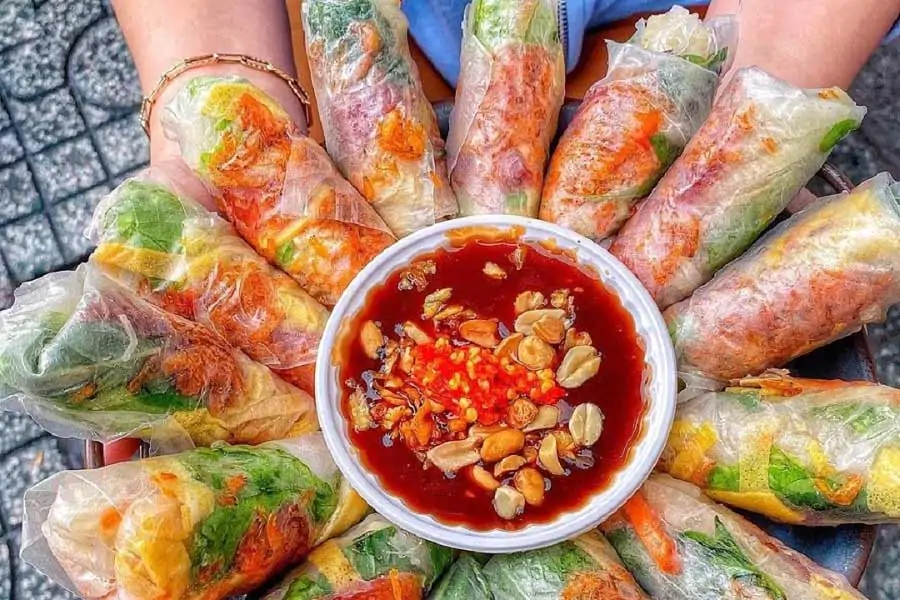
Address of the places you may come:
- Pho Cuon 25 Ngu Xa (Rolled Pho), Ba Dinh District, Hanoi
- Nem Nuong Di Nuong (grilled pork sausage), 29 – 31 Le Loi, Nha Trang, Khanh Hoa Province
- Goi Cuon Tom Nhay: 424 Lac Long Quan (Pho Cuon with shrimp), Ward 5, District 11, HCMC
- Goi Cuon Le Van Sy: 359/1/9A Le Van Sy, Ward 13, District 3, HCMC
- Goi Cuon Ngon Ngon: 322/13 An Duong Vuong, Ward 4, District 5, HCM
Price from US$2/ plate (5-10 rolls)
Bun Cha
The next popular Vietnamese food should be Bun Cha, a symbolic dish in Hanoi for its luscious taste of grilled pork (Cha), served with vermicelli and Nuoc Cham (fish sauce mixed with garlic, chili sugar, and vinegar).
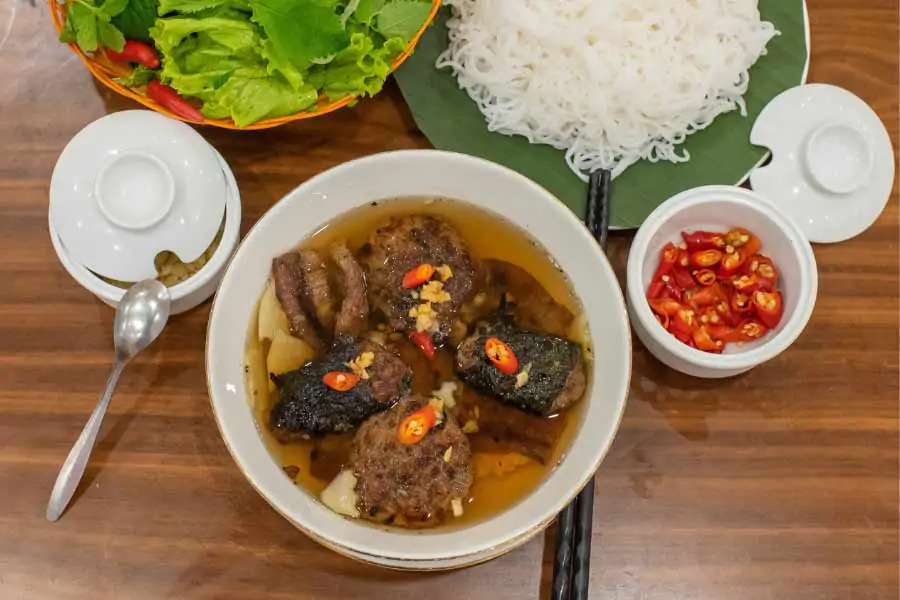
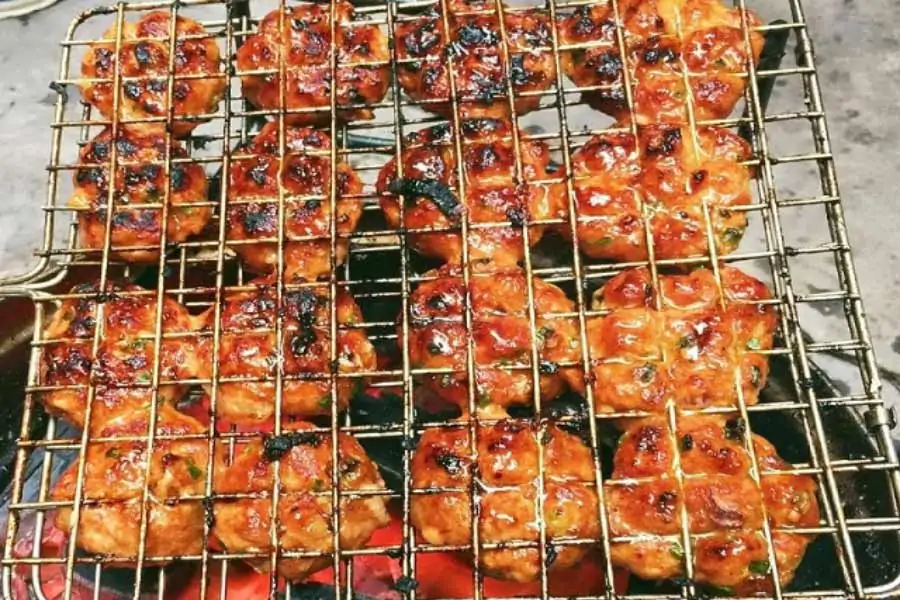
“Cha” is a Vietnamese name for pork patties or sliced pork, charcoal grilled after marinated with seasonings to leverage the flavors. It tastes, irresistibly, juicy, savory, tender, and amazing. The dish is always served with a bowl of “Cha” and Nuoc Cham, a plate of vermicelli, fresh vegetables, and pickled carrot, daikon, and papaya for balance. Nuoc Cham of Bun Cha is different from Nuoc Cham of Goi Cuon based on a variety in the portion of seasonings. It is light, flavorful, and filled with a smoky hint of grilled pork parries. Enjoying Bun Cha, the locals will dip vermicelli in the dipping sauce, then tear favorite herbs into bite-sized pieces to add to the bowl, swish everything around to make it blend, and take it all in one bite.

Just discover this iconic dish, here are some suggestions:
- Bun Cha Huong Lien (Michelin Selected 2023), 24 Le Van Huu Street, Hanoi
- Bun Cha Hang Quat, 74 Hang Quat, Hanoi
- Bun Cha Nem 41 Cu Dong, 41 Cua Dog, Hanoi
Price from US$2/ portion
Cao Lau
Cao Lau is listed in the top 5 Vietnamese dishes in this guide. It comprises chewy noodles, smoky pork, crisp green, crunchy croutons, and bean sprouts, blended in the sauce. Still based on a basis of balance in flavors, like other Vietnamese dishes, Cao Lau combines various hints including sour, pungent, astringent, and sweet. To enjoy it, guests should mix it all and enjoy perfection made up of how these ingredients go well together.

Although its name, and appearance are somehow similar to a Chinese dish, Cao Lau is remarked as a signature Vietnamese dish, or even, a unique treat of Hoi An only. Its origin is still a mystery, but the locals believe that it cannot be duplicated outside the town. Because, the water for cooking Cao Lau should be taken from a well nearby Ba Le well, which is dug by the Cham people, at the end of an alley opposite 35 Phan Chau Trinh. If you are traveling to this ancient town, why not miss:
- Cao Lau Khong Gian Xanh, 687 Hai Ba Trung, Hoi An, Quang Nam Province
- Cao Lau Hoi An Trung Bac, 87 Tran Phu, Hoi An, Quang Nam Province
- Cao Lau Ba Thanh, 26 Thai Phien, Hoi An, Quang Nam Province
- Cao Lau Lien, 26 Thai Phien, Hoi An, Quang Nam Province
Price from US$2/ portion
Mi Quang
Mi Quang is popular Quang Nam Provice’s noodles where famous destinations like Da Nang and Hoi An are located. Everything about this dish, from a combination of the ingredients, and a taste to its plating presence, showcases the signature of food in the Middle region of Vietnam. Similar to Cao Lau, there are elements including rice noodles in a flat shape, broth, meats like chicken, pork, beef, shrimp, or sometimes fish, fresh herbs, peanuts, and a crispy rice cracker.
The rice noodles are made from rice flour, just like Pho, but they are chewy, adding more texture to the dish. Its beautiful yellow color is from an infusion of turmeric, an inevitable seasoning of traditional dishes. Broth of Mi Quang is made by cooking pork or chicken bones in hours to extract a heavenly flavor and added to the bowl at a medium amount, not like Pho. Before traveling to Hoi An for Cao Lau, check out spots for Mi Quang in Da Nang as below:


- Mi Quang Ba Vi (chicken), 166 Le Dinh Duong, Hai Chau, Da Nang
- Mi Quang Dai Loc (fish), 65 Vu Ngoc Phan, Lien Chieu, Da Nang
- Mi Quang Thuy (veggie), 122 Hoang Dieu, Hai Chau, Da Nang
- Mi Quang Hue, 135 Tieu La, Hai Chau, Da Nang
Price from US$1 – US$3/ bowl
Banh Xeo
In the Vietnamese cuisine menu, visitors would find Banh Xeo as one of the most dynamic dishes with variations across the country. The name, itself, is interesting as “Xeo” describes a sizzling sound when flour is put into a fried pan with hot oil for a crusty texture. There are two popular versions, which are Banh Xeo in the Middle provinces or cities like Da Nang, Nha Trang, Quy Nho, and Banh Xeo in the East-Southern region.
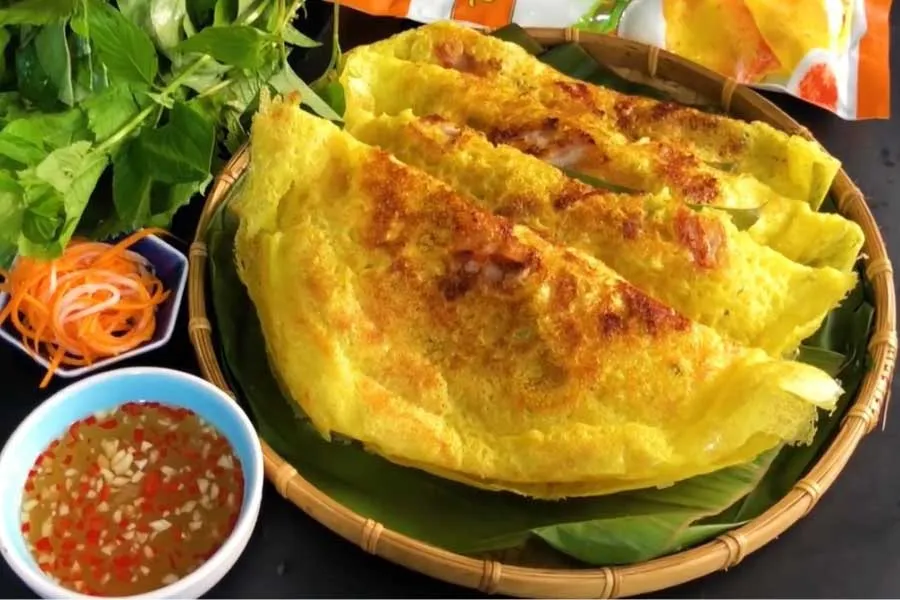
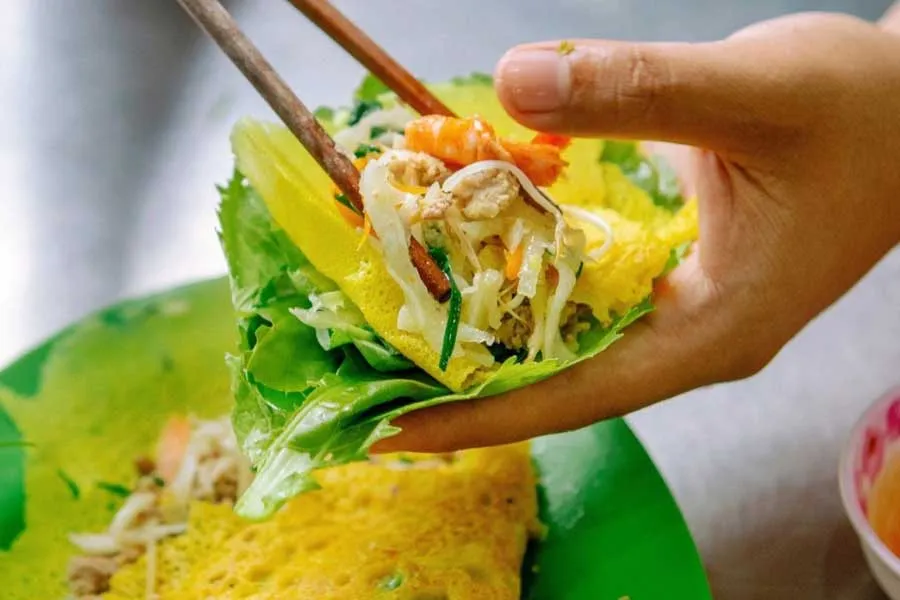
Banh Xeo in the Middle provinces are smaller with fillings of fresh seafood like shrimp and squid because the majority of these cities are located near the ocean with many fishing villages. The flour, after being fried, is not too crispy nor too soft; it is just perfect for wrapping in rice paper with fresh vegetables, pineapple, carrot, and chili before being dipped into a sauce of fermented fish sauce adding peanut for a tantalizing fragrance. Whereas, Banh Xeo in the East-Southern region is larger with fillings of shrimp, pork, and mashed green beans. The locals also add coconut water to the flour for a sweet aftertaste. To enjoy it, people here usually cut Banh Xeo into pieces, put them in a bowl, tear herbs, and add the fish sauce, mixed with sugar, vinegar, garlic, and chili, then get in one bite.
Just discover Banh Xeo and enjoy it like the locals at:
Da Nang (Middle style):
- Banh Xeo Ba Tinh, K280/14 Hoang Dieu, Hai Chau, Da Nang
- Banh Xeo Ba Duong, K280/23 Hoang Dieu
Can Tho city (East-Southern style):
- Banh Xeo Muoi Xiem, 13/3 Nguyen Chi Thanh, Can Tho
- Banh Xeo 7 Toi, 45 Hoang Quoc Viet, Ninh Kieu, Can Tho
Price from US$1 – US$3/ portion
Che
Che or sweet soup is the only dessert listed in this guide of the most popular Vietnamese food, but its charm is not less than any of the others. It originated from China, spread to Vietnam, and is similar to some desserts in other countries like Malaysia, or Thailand. However, Vietnamese Che is signed by diverse versions from the North to the South, especially since there are more than 10 types of Che in Hue, the old Vietnam capital, only.

To make Che, the locals usually cook diluted sugar water, and add (or not) coconut water to create a natural sweet flavor until the texture becomes thicker; Then, toppings are black beans, red beans, sweet lotus seeds, glutinous rice, pudding, grass jelly, tropical fruits like jack fruits or mango, and coconut milk on top. Nowadays, there are even more modifications of Che, known as the modern sweet soups, with toppings like tapioca, red Dragon fruit, etc. In general, it tastes sweet but gentle and pleasant. A mix of fruits, seeds, and other ingredients gives it a great texture and you may find it interesting to guess what kind of toppings you are enjoying.
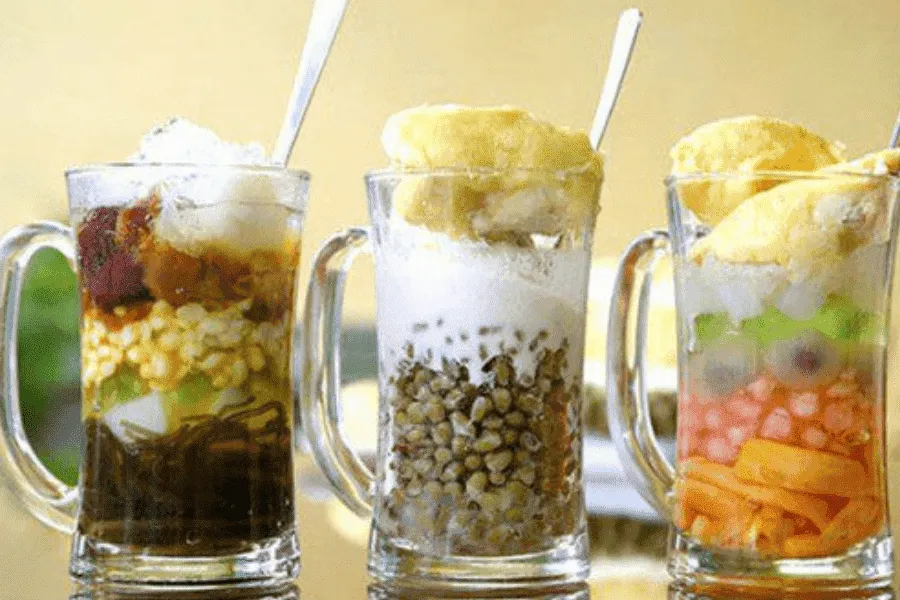
Mentioning Che without stating Che in Hue is such a mistake, as this ancient capital is a land of multiple sophisticated sweet soups, known as Royal sweet soup, including Che Chuoi (banana sweet soup), Bot Loc Heo Quay (Che with crispy pork in rice flour balls), Che Hoa Cau (Areca flower sweet soup), Che Com (green sticky rice Che), Che Hat Sen (Lotus seed Che), and more.
For Che in Hanoi (traditional), you must try:
- Che 4 seasons, 4 Hang Can, Hanoi
- Che Ba Thin, 1 Bat Dan, Hanoi
Popular Hue’s Che is sold at:
- Che Cam, 10 Nguyen Sinh Cung, Hue
- Che in Dong Ba market
Da Nang is famous for Durian Che:
- Che Xuan Trang, 31 Le Duan, Hai Chau, Da Nang
- Che Chi Chi, 198 Tran Hung Dao, Thanh Khe, Da Nang
While being in Ho Chi Minh, just try:
- Che Ky Dong, 16C Ky Dong, District 3, HCMC
- 24 Sweet Soup, 24 Ton that Hiep, District 11, HCMC
Price from US$1/ portion
Just explore!
Vietnam’s culinary landscape is a vibrant tapestry of flavors, textures, and aromas that captivate the senses and leave an indelible mark on the palate. As you journey through the bustling markets and tranquil countryside of Vietnam, you’ll discover that every meal is an opportunity to connect with the heart and soul of the nation. With its unparalleled culinary offerings, Vietnam rightfully earns its place as one of the top culinary destinations in the world, inviting food enthusiasts from around the globe to savor its unique and unforgettable cuisine.
 huyen
huyen June 14, 2024
June 14, 2024 Vietnam
Vietnam
 543
543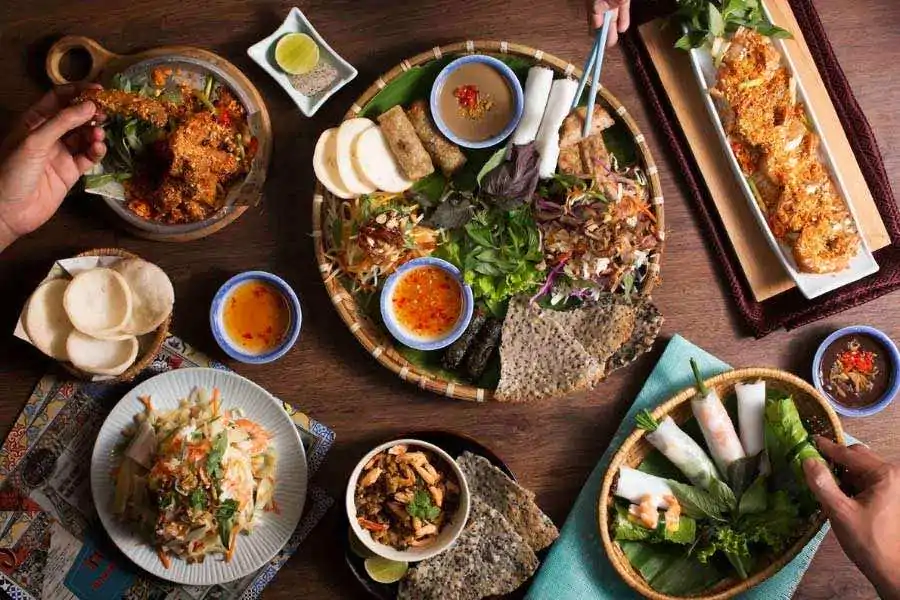
 YOU MAY ALSO LIKE
YOU MAY ALSO LIKE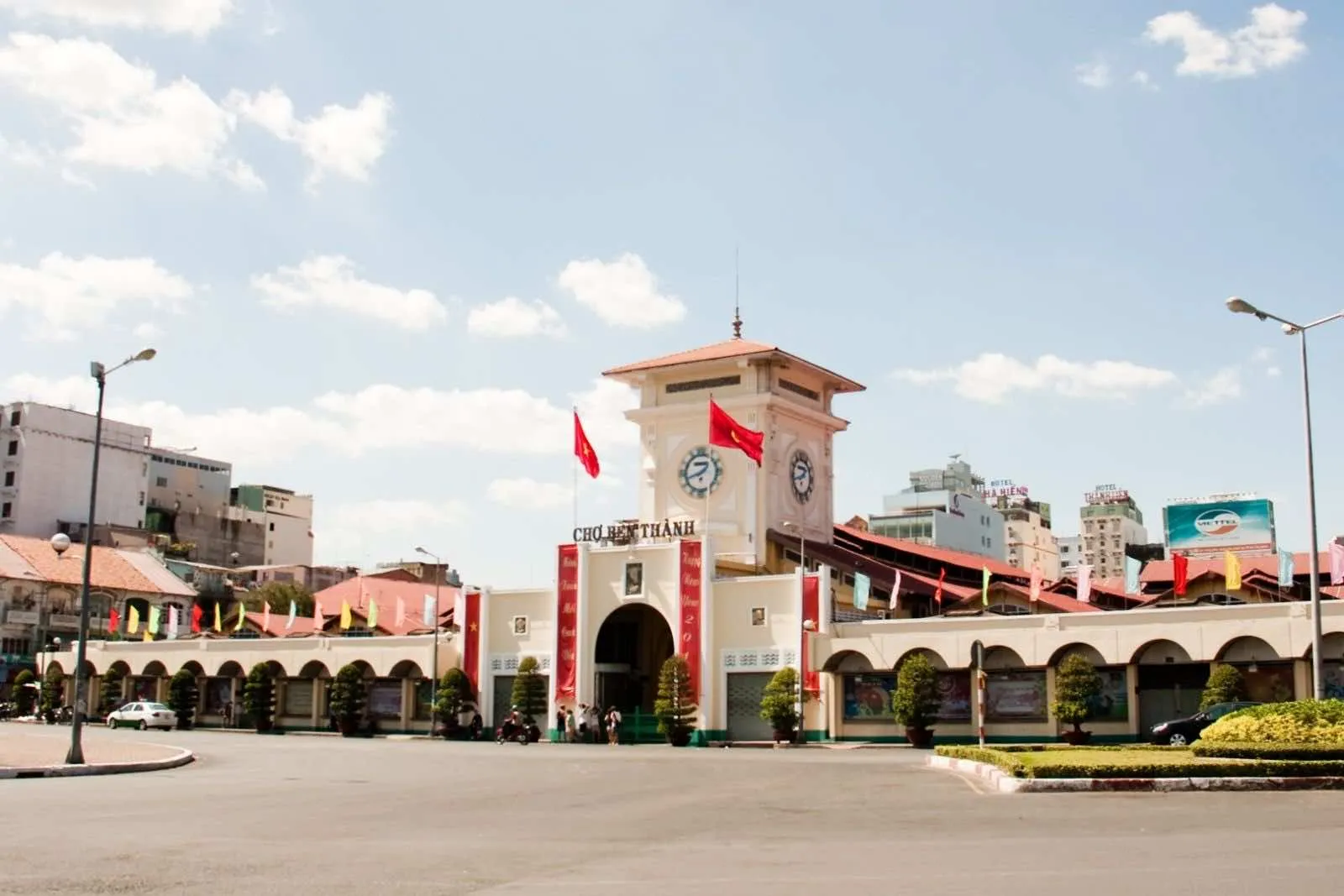
 read more
read more
